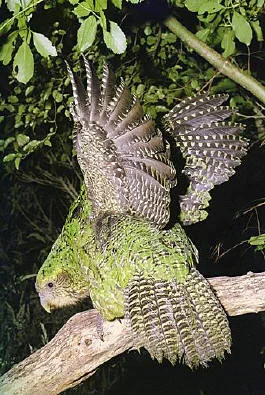The kakapo is a kind of parrot.
It cannot fly.
It is the heaviest of all the parrots.
The kakapo lives in New Zealand.
It sleeps all day and is active at night.
What is a kakapo?
The kakapo is the largest parrot and the only one that is flightless.
Habitat and Distribution (where it is found)
The kakapo is found only in New Zealand, and used to be found all through the mountain areas of the North Island, South Island and on Stewart Island.
Its habitat is mossy forests and alpine scrub.
Appearance and Behaviours
Kakapos are a soft green colour, with black stripes on the back and pale yellowy feathers underneath their bodies. Females are smaller and less brightly coloured than the males. The kakapo is the heaviest of the parrot family, and weighs up to 4kg.
The kakapo is a flightless bird. The birds leap from branch to branch and to the ground from low tree branches. Kakapos have strong legs. Their wings are not used for flying, but for balance while they walk or run.
The birds are solitary, which means they live alone. They roost under cover during the day and become active at night. Their diet consists of leaves, buds, roots, flowers, fruit, nectar and seeds.
Life Cycle
Kakapos have an unusual breeding system, called a 'lek' system. Males gather on display grounds, which are hollows in the ground dug out by the males, and linked by tracks. Males clip the plants on the sides of the hollows and along the tracks, which can be over 50m long. Sitting in a hollow, each male makes a booming noise for hours to attract a female. To produce the sound, males inflate air sacs in the chest and belly. The sound can be heard up to 5km away. They do this every night through the summer months. Females choose from the competing males. attracted by the sound and by a dance the male does when a female arrives at his hollow. After mating, the male leaves the female, who lays 2 or 3 eggs on the ground, under a grass tussock or at the bottom of a rotten tree. Kakapos only mate every 3 or 4 years, breeding only in years when there is plenty of food available. Females must leave nests unattended for hours when they search for food at night. Once the eggs have hatched, the female returns every few hours to feed the chicks. Kakapo chicks stay on the ground, and are very noisy, making them easy for predators to find. Kakapos live for about 60 years.
Conservation Status
The kakapo is Critically Endangered, which means it is very close to being extinct. There are only about 150 of them.
There are few mammals native to New Zealand, just 2 species of bat. The native animals were birds and reptiles. The flightless kakapo had no predators, and was therefore very vulnerable to introduced predators such as ferrets, rats, cats, dogs, stoats and foxes. Kakapos nest on the ground, which makes its eggs and chicks particularly vulnerable to these introduced predators. By the 1990s, the kakapo was extinct in the wild. A few remaining birds have been taken to some small islands which are uninhabited and which are therefore free of introduced animal predators. However, there are only a small number of remaining birds, and this small number could easily be wiped out by disease or if predators are introduced to the islands where the recovery programs are in place.
It’s a good idea to get information from more than one source!
Watch a video:
https://www.youtube.com/watch?v=bhTU__jVP8E



